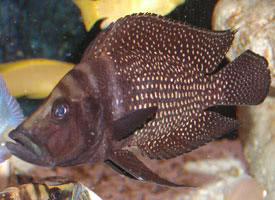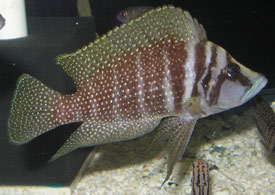
 Magyarul / Hungarian
Magyarul / Hungarian



- Scientific name: Altolamprologus calvus
- Common name: Pearly lamprologus, Pearly compressiceps
- Synonyms: Lamprologus calvus
- Group: Cichlids
- Habitat: Africa; Lake Tanganyika
- Size: 14 cm.
- Biotope: Pearly lamprologus inhabit rocky littoral zones
- Social behavior: Territorial, the pearly lamprologus are very sedate, sometimes even shy. Try introducing some lively fish to help bring this species out of hiding. They do not dig and are plant friendly. Can be combined with other Lake Tanganyika cichlids.
- Diet: Carnivores; All kind of live foods. The Pearly lamprologus are difficult to acclimate to flake food.
- Breeding: Very hard
- Tank: Minimum 200 litres
- Population: 2 males and 3-4 females for 200 litres
- Decoration: Needs roomy tanks with stone and rock structures to provide many crevices, niches and caves. Use dense vegetation of Hygrophila corymbosa and Microsorium pteropus at the edges and a sandy bottom. Cover the tank well, because they are precise jumpers.
- Temperature: 23-25°C
- pH: 7-8
- Hardness: 10-15NK°
- Lifespan: 10-11 years
Description: Altolamprologus calvus have an elongated and laterally compressed body. The back is arched and the dorsal fin is elongated. The body color is generally off-white to light brown, and the fins are beige. The body is marked with 10 to 12 transverse bars, and is spotted with small whitish markings. A dark black marking extends from the upper lip, through the eye, and back down to the bottom of the gill cover. The anal and dorsal fin have a darker edging. Altolamprologus calvus is very similar in appearance to Altolamprologus compressiceps, to which it is closely related, but A. calvus has a longer , shallower body and has no scales on the forehead between the eyes. The males grow larger, have longer pelvic fins and more pointed, elongated anal and dorsal fins. Cave spawner.
For breeding use water with a pH from 7.0-7.5, a water hardness from 10-14 dH, and a temperature from 77-82°F (25-28°C). Keep 2 males and three to five females in the breeding tank. Breeding was preferably performed in crevices and caves. Up to 200, 2mm dirty yellow to greenish eggs are laid in the cave. Spawns are guarded by the female. The larvae hatch after about 50 hours at 25 °C; after an additional 8-10 days, they are free swimming. Feed with artemia nauplii. Full-grown Altolamprologus calvus are sensitive to new water, so take care when making water changes.










